Mode-locked thin-disk lasers have resolved several challenges and are expected to be well suited to a range of scientific and materials processing applications.
CHRIS R. PHILLIPS AND URSULA KELLER, ETH ZÜRICH
In both scientific research and in
industrial materials processing, high-average-power diode-pumped solid-state lasers have become an indispensable tool. A crucial aspect of these lasers is the need for effective heat removal without introducing thermo-optic distortions. One way
to address this challenge is by shaping the laser gain medium as a very thin disk, as demonstrated by A. Giesen and colleagues1. Along with supporting power scaling by using a larger beam on the disk, this approach is advantageous for generating ultrashort pulses with high peak power. Since the laser beam only passes through a small amount of material, high peak powers can also be achieved before the onset of detrimental nonlinear optical effects. When implemented with ytterbium-doped gain materials, in particular ytterbium-doped yttrium aluminum garnet (Yb:YAG), femtosecond pulsed lasers with average powers at the kilowatt level have been obtained.
Research has been focused on new laser architectures and gain materials to extend the frontiers of thin-disk laser performance and access numerous scientific and industrial applications.
Thin-disk laser architecture
Thin-disk lasers leverage the geometrical shape of the gain material to enable effective heat extraction. The thickness of the disk is typically around 0.1 mm, while the transverse extent can measure several centimeters. A thin-disk apparatus (Figure 1) includes optics for reflecting the pump beam several times on the disk. A magnification of the mounted thin disk is shown in Figure 2.
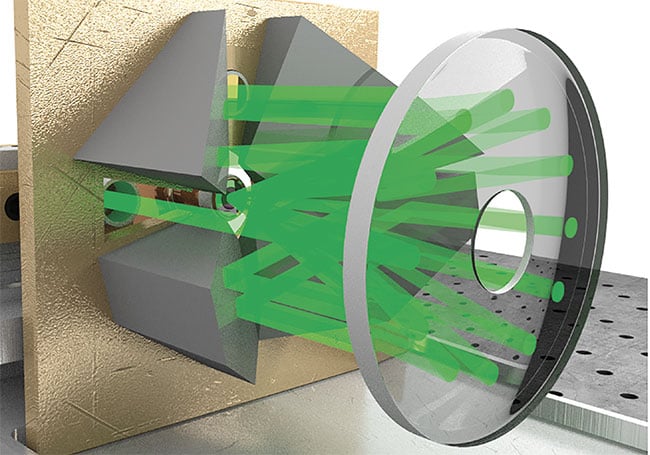
Figure 1. A conceptual illustration of a thin-disk laser head, showing the disk and the many reflections of the pump beam onto the disk. Adapted from Reference 2. Courtesy of Ursula Keller Group.
Since the laser and pump beams used are much larger than the thickness of the disk, heat flows easily through its thin axis and into the heat sink, which is attached to the back side. The extent to which the disk heats up during laser operation can be reduced by making the disk as thin as possible. Yb:YAG is currently the standard gain material for thin-disk lasers because of its favorable optical, thermal, and mechanical properties.
For laser operation, an antireflective coating is applied to the front facet and a highly reflective coating to the back facet of the disk, yielding an active mirror
structure. Most of the pump light must be absorbed in this structure to reach high optical efficiency. However, because of the small thickness, one reflection does not yield enough absorption. Therefore, a parabolic mirror arrangement is placed close to the disk to facilitate many reflections of the pump beam (Figure 1).
The laser gain from one reflection on the disk is also constrained by the small thickness and is typically on the order of 10%. The gain per unit length is drastically higher than for Yb-doped fiber lasers and is sufficient to achieve high-average output powers, simply by incorporating the thin disk into an optical resonator. Two examples of this are mode-locked oscillators2 and regenerative amplifiers3 (discussed below). Alternatively, significant amplification without an optical resonator can be achieved by reflecting the laser beam on the disk many times. Advanced optical multipass designs have been developed for this purpose4.
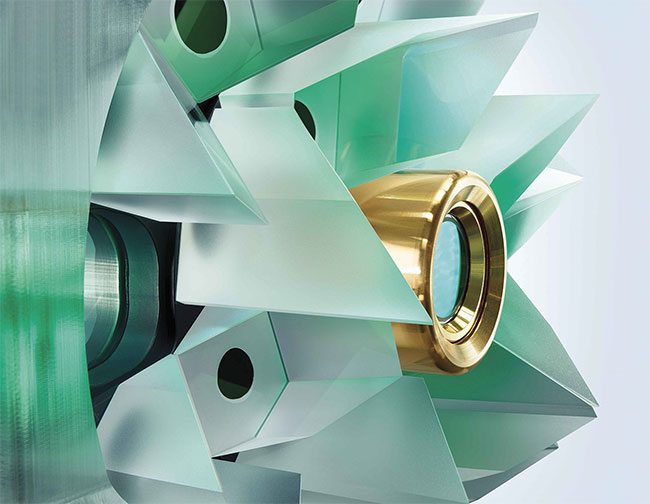
Figure 2. A magnification of a commercial thin-disk head. The monolithic prisms surrounding the disk are used to route the pump beam between reflections on a parabolic mirror. Courtesy of TRUMPF.
Thin-disk laser applications
As one of the major commercialized techniques for generating >100-W ultrafast laser systems, thin-disk lasers have found extensive use in machining of materials to create features with micrometer precision (microprocessing)5. The use of ultrashort pulses, around one picosecond in duration, offers a key advantage in such processing because ablation of the target area occurs faster than the transfer of heat to the surrounding material. As a result, the so-called heat-affected zone surrounding the removed material is minimized, yielding sharper features.
A very wide variety of materials can be processed, particularly when the laser is combined with nonlinear frequency conversion to access UV wavelengths. Such lasers are widely used for cutting and drilling of various challenging materials
and targets, such as sapphire, display glass, ceramics, foil cutting, and drilling of injection nozzles (Figure 3). Some commercial ultrafast thin-disk systems include the TruMicro Series 5000 from TRUMPF, the Dira Series from TRUMPF Scientific Lasers, and the VaryDisk series from Dausinger + Giesen GmbH.
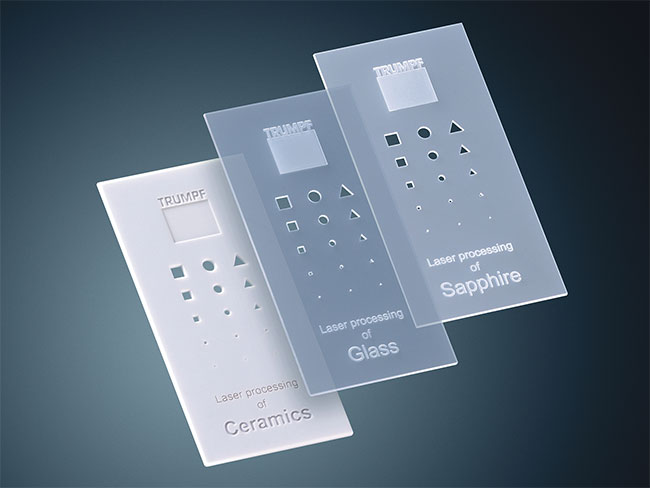
Figure 3. One application of ultrafast lasers involves machining of brittle materials. Courtesy of TRUMPF.
In addition to industrial applications, there has been a strong demand in recent years for high-pulse-energy, high-average-
power laser systems, motivated by scientific applications. There, the intense NIR pump pulses are used to drive nonlinear processes to generate secondary light sources.
Examples include nonlinear pulse compression to reach terawatt or even larger peak powers, production of attosecond-duration pulses in the extreme ultraviolet via high-harmonic generation, and optical parametric chirped pulse amplification to generate extremely short pulses in the near- or mid-IR (Figure 4)6. The resulting light can then facilitate fundamental investigations of ultrafast light-matter interactions on femtosecond (10−15 s) or attosecond (10−18 s) timescales via pump-probe measurements.
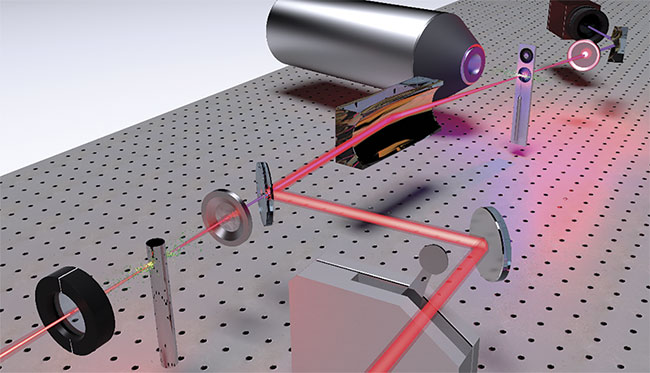
Figure 4. A conceptual illustration of an ‘attoline’ apparatus. Extreme UV light is generated via high-
harmonic generation and is subsequently used for pump-probe studies with temporal resolution on the
scale of attoseconds. Adapted from Reference 6. Courtesy of Ursula Keller Group.
These scientific applications require relatively high-energy pulses. However, because the laser systems available have historically been limited in average power, low pulse repetition rates had to be used, leading to slow experiments. With modern industrial laser technologies, the situation
has changed. By starting with a high-power
pump laser, much higher repetition rates can be achieved, enabling faster measurements with better sensitivity, while still maintaining a tabletop setup suitable for academic research labs. Moreover, major facilities such as the Extreme Light Infrastructure (ELI) are under development to further extend the boundaries of high-energy high-repetition-rate light sources.
Various high-power laser technologies are competing to fulfill the demanding requirements of these efforts, including thin-disk, fiber, and slab amplifiers. A particular strength of thin-disk regenerative amplifiers in this context is their diffraction-limited performance at very high pulse energies. For example, in recent years ultrafast thin-disk laser systems have reached kilowatt average power levels and 200-mJ pulse energies3, with ongoing efforts approaching Joule-level pulse energies.
Ultrafast thin-disk oscillators
Many high-power laser systems have used a master oscillator power amplifier (MOPA) architecture, in which a low-power oscillator is pulse-picked, temporally stretched, directed through a chain of laser amplifiers, and then compressed. Thin-disk technology has enabled an alternative and potentially simpler approach: directly generating subpicosecond, high-power pulses from a single mode-locked oscillator.
These oscillators can be mode-locked by adding a semiconductor saturable absorber mirror (SESAM) into the optical resonator, provided certain design steps important for high-power operation are taken. The SESAM itself is basically power-scalable, and in such lasers the optical resonator can be designed to be minimally insensitive to thermal-lensing effects on the thin disk, which is beneficial for system robustness at high average power. Further, the carrier-
envelope offset frequency of the laser can be stabilized, which is important for attosecond pump-probe experiments. Since first demonstrating the mode-locked thin-disk oscillator in 2000, our group has advanced these lasers extensively in terms of achieving short pulses and high average powers2.
Mode-locked thin-disk lasers have faced three main challenges during the last several years: managing the strong intracavity optical nonlinearities, achieving shorter pulses given the limited choice of high-power-compatible gain materials, and scaling the average output power. Several recent research results, summarized below, have helped address these challenges.
Nonlinearity management
A long-standing issue in mode-locked thin-disk lasers has been the optical nonlinearity of air. The intracavity pulses are so intense that the weak intensity-dependent refractive index of air can be enough to destabilize the normal ultrashort-pulse formation process. Consequently, the highest
powers to date have been achieved by operating in a near-vacuum environment, with the corresponding experimental complexity involved.
A new solution to this problem was recently demonstrated. By adding a specially designed nonlinear crystal with a negative optical nonlinearity inside the laser resonator, an equal and opposite nonlinearity to that of air can be obtained. In this way, the nonlinearity of the intracavity gas (e.g., air or nitrogen) can be canceled while still operating the laser at ambient air pressure. To obtain the required negative optical nonlinearity, a second-harmonic generation crystal tuned far from phase matching was used, yielding the so-called cascaded quadratic nonlinearity regime. This enabled canceling the unwanted nonlinearity of air without the need for complex vacuum equipment. This practical approach enabled a SESAM-mode-locked Yb:YAG thin-disk laser with 210-W average power and 780-fs pulse duration7. The performance of the laser versus pump power is shown in Figure 5.
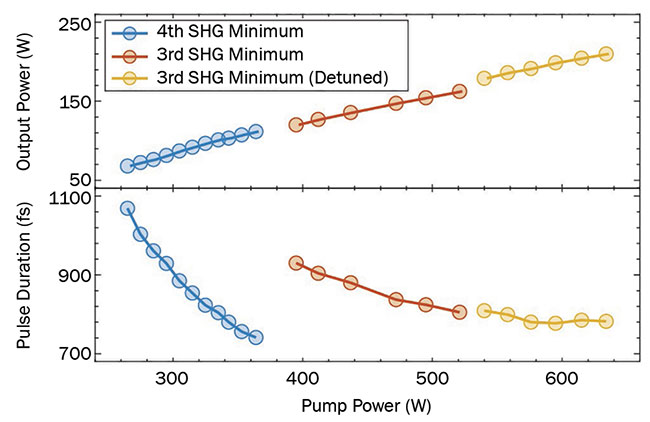
Figure 5. Performance reported when incorporating a negative-nonlinearity crystal into the cavity. The various curves indicate operation around different designs of the nonlinear second-harmonic generation (SHG) crystal (blue: 4th minimum of the SHG tuning curve; red and yellow: 3rd minimum of the SHG tuning curve). Adapted from Reference 7. Courtesy of Ursula Keller Group.
Short-pulse thin-disk lasers
In another set of experiments, shorter pulses than those typically obtained from SESAM-mode-locked Yb:YAG thin-disk lasers were pursued. Extensive research has been devoted toward new gain materials for this purpose. Materials such as Yb:Lu2O3 or Yb:CaGdAlO4 appear promising for approaching the average power
performance of YAG while supporting shorter pulses because of their broader emission cross sections. Nonetheless, a trade-off remains between high-power-
compatible and short-pulse-compatible gain materials.
An alternative approach to shorter pulses, while still using the well-
established Yb:YAG material, is to modify the mode-locking mechanism. For example, up to 270-W average power was
obtained in a Kerr-lens mode-locked (KLM) oscillator8, demonstrating the power scalability of KLM and its capacity to generate shorter pulses because of its
fast nonlinear response. Ideally, a mode-
locking mechanism would simultaneously offer the advantages of the SESAM (robust operation with stability of the laser cavity decoupled from the pulse formation mechanism) and of KLM (which offers a fast saturable loss mechanism). The frequency-doubling nonlinear mirror mode-locking technique, first proposed in 1988 by K.A. Stankov, may offer both of these advantages. In earlier work, this technique was successfully used with bulk crystal lasers, although the laser peak power achievable was limited.
Recently, this technique was demonstrated inside a thin-disk laser. In the first proof-of-principle thin-disk demonstration, moderate average power of 21 W was obtained, with pulses as short as 323 fs9.
In ongoing work, we have scaled the power to 87 W with 586-fs pulse duration. Future scaling to >100-W level
appears feasible with commercially available low-absorption nonlinear crystals.
High-power milestones
Reaching new milestones in terms of average output power is a core goal of this line of research. However, power scaling also leads to kilowatt-level average powers on the intracavity optics. This can be troublesome for the SESAM and for dispersion compensating mirrors, whose thin-film structures are more complicated than for standard highly reflective mirrors, leading to stronger thermal effects and lower laser-
induced damage thresholds. Therefore, it is beneficial for the mode-locked laser to require minimum intracavity power and group delay dispersion for a given output power (while still satisfying the various requirements for stable pulse formation).
These considerations favor a cavity design in which the laser is reflected multiple times on the disk, to provide higher gain and enable higher output coupling rates. Simultaneously reducing the required dispersion can be accomplished by the SPM cancellation method described above7, or by operating in a low-pressure environment. The latter approach turns out to yield reduced thermal lensing effects at the same time, for the following reason. In high-power operation, the pumped region of the thin disk can heat up to around 100 °C.
This causes the air near the disk to be heated up, which in turn causes a gas-lensing effect because of the thermo-optic coefficient of air10. Under normal operation, this gas lens contributes a significant fraction of the overall thermal lens of the disk, but is removed by operation in vacuum.
Investigation of this effect showed that SESAM mode-locking in a low-pressure environment with a multipass cavity represents a particularly promising approach for power scaling. Based on these considerations, the laser shown in Figure 6 was developed and operated at a pressure of 30 mbar of N2. This yielded a new world-record output power for a thin-disk oscillator. The laser produced 350-W average power with 940-fs pulses, and a pulse energy of 40 µJ11.

Figure 6. Ultrafast thin-disk oscillator cavity, producing 350-W average power with 940-fs pulse duration, at 8.8-MHz repetition rate. The laser is enclosed in a sealed box, enabling a low-pressure environment inside the laser cavity (30 mbar N2). Adapted from Reference 10. Courtesy of Ursula Keller Group.
In summary, these recent results have helped address core challenges faced by mode-locked thin-disk oscillators, potentially enabling many applications of these lasers. Further extensions of the laser performance to even higher powers, shorter pulses, and simpler systems can be anticipated in the future.
Meet the authors
Chris R. Phillips is a senior research scientist in the group of professor Ursula Keller at ETH Zürich; email: [email protected].
Ursula Keller is professor in the physics department at ETH Zürich and director of NCCR MUST (National Center of Competence in Research: Molecular Ultrafast Science and Technology) in Switzerland: email: [email protected].
References
1. A. Giesen et al. (1994). Scalable concept for diode-pumped high-power solid-state lasers. Appl Phys B, Vol. 58, pp. 365-372.
2. C.J. Saraceno et al. (2015). Toward millijoule-level high-power ultrafast thin-disk oscillator. IEEE J Sel Top in Quantum Electro, Vol. 21, No. 1, 1100318.
3. T. Nubbemeyer et al. (2017). 1 kW, 200 mJ picosecond thin-disk laser system. Opt Lett, Vol. 42, pp. 1381-1384.
4. J.-P. Negel et al. (2015). Ultrafast thin-disk multipass laser amplifier delivering 1.4 kW (4.7 mJ, 1030 nm) average power converted to 820 W at 515 nm and 234 W at 343 nm. Opt Express, Vol. 23, pp. 21064-21077.
5. F. Dreisow et al. (2016). Ultrashort Pulse Laser Technology: Laser Sources and Applications. S. Nolte et al., eds. Springer Series in Optical Sciences, p. 195.
6. M. Lucchini et al. (2016). Attosecond
dynamical Franz-Keldysh effect in polycrystalline diamond. Science, Vol. 353,
pp. 916 - 919.
7. F. Saltarelli et al. (2018). Self-phase modulation cancellation in a high-power ultrafast thin-disk laser oscillator. Optica, Vol. 5,
pp. 1603-1606.
8. J. Brons et al. (2014). Energy scaling of Kerr-lens mode-locked thin-disk oscillators. Opt Lett, Vol. 39, pp. 6442-6445.
9. F. Saltarelli (2017). Modelocking of a thin-disk laser with the frequency-doubling nonlinear-mirror technique. Opt Express, Vol. 25, pp. 23254-23266.
10. A. Diebold et al. (2018). Gas-lens effect in kW-class thin-disk lasers. Opt Express,
Vol. 26, pp. 12648-12659.
11. F. Saltarelli et al. (2019). Power scaling of ultrafast oscillators: 350-W average-power sub-picosecond thin-disk laser. Opt Express, Vol. 27, pp. 31465-31474.